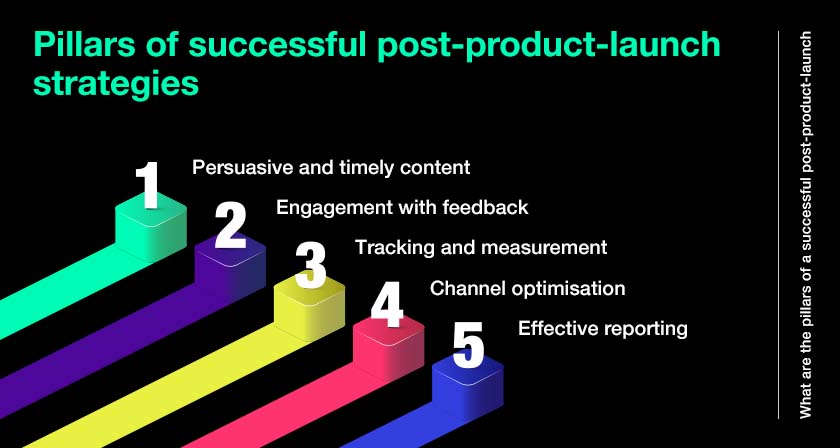
What are the pillars of a successful post-product-launch strategy?
Launching a new product is just the beginning. Here are the next steps.
So, you’re close to launching a new product. For months or years, you and your team have worked on the next big thing, and you’ve made many challenging strategic decisions along the way. But now that you finally have a set product launch strategy in place, is it time to kick back and celebrate?
The answer is…not quite.
First off, it’s important to keep in mind that an effective product launch doesn’t just revolve around a single event. It’s also about finding ways to continue the momentum after the launch, so your success doesn’t fizzle right away.
This article explains the importance of a post-product-launch strategy and shares the necessary features of a successful one.
Why is a post-product-launch strategy necessary?
You might notice that many product marketers tend to focus heavily on product launches—in fact, a quick Google search on ‘how to successfully launch a new product’ brings up over 40,000,000 results.
Some organisations will repeat the promotional activities meant to support a launch and extend it across the product’s entire roadmap. Unfortunately, this is a misstep because the needs of your target personas in the pre-launch stage and the post-launch stage are not the same.
Having a post-launch strategy for your product is important because it allows you to connect with prospects in a more contextual and timely way, which will improve the effectiveness of your marketing and reduce customer churn before it’s too late. It also ensures that you’re prepared to pivot or change direction if necessary. Your organisation’s launch event may be a success—but without an idea of how to keep the momentum going, it might be tempting to double down on sunk costs if you don’t see the results you initially saw in the pre-launch and launch stage. Having a specific action plan will empower you to adapt and optimise, instead of doing more of what’s no longer working. Plus, in the long term, your next launch (whether it’s a new product or feature) will run much more smoothly as a result.

Pillars of successful post-product-launch strategies
Post-product-launch strategies can vary greatly depending on factors like the nature of the product, organisational resources, and so on. However, there are certain essential pillars that all successful strategies have.
Persuasive and timely content
An important pillar of any post-launch strategy is content—or more specifically, content that educates and persuades your audience to see the value of your new product. The last thing you’d want to do after releasing your product is to go silent on all your marketing channels!
.jpg)
In the weeks following your launch, it is key that you shift the focus from what your product is to how and why your target personas should use it over other alternatives. Consider the risks from their perspective. Even if they’ve already heard about your new product (and have a favourable view of it), they might still have the remaining concerns:
- What if the product doesn’t work or function as intended?
- What if I don’t get my money’s worth (or my return on investment)?
- What if I waste unnecessary time trying to switch or get used to the product?
As a marketer, the post-launch stage is your opportunity to address these concerns. This is especially important in a B2B context because the buying process requires a higher level of psychological involvement from not one, but multiple decision-makers. What’s more, organisations typically take time to adapt to new products.
One way of alleviating the perceived risks of your offering is by getting into the specifics. If your product is software, you may choose to create eGuides, webinar decks and articles to resolve underlying questions and demonstrate how potential buyers can use your product to advance their goals. A good example would be Hubspot; every year, the company publishes a comprehensive series of informative assets that go live after INBOUND, their annual product launch event.
How to get started: Make sure your organisation has a content calendar first. This will help you and your team organise content ideas—and decide when to publish assets, so they have maximum impact. It’s also important to have a content scheduling tool in place. Things can slip away quickly otherwise!
Engagement with feedback
There is one important thing that differentiates post-launch from pre-launch, and it’s to do with qualitative feedback. During the pre-launch stage, you’ll have a set of assumptions and hypotheses about why your product matters to target customers, based on the insights you gained from audience research and beta testing. However, you’ll only be able to get a clearer picture after it goes live.
During the post-launch stage, companies have the unique opportunity to harness unfiltered qualitative feedback at a much wider scale. It could be positive or negative, but no matter what you do, you must monitor all of it. At this point, breadth is key.
Once user feedback starts rolling in, you’ll be in a good position to categorise the sentiments. This will help your organisation engage with it in a proactive and meaningful way. If the feedback is positive, use it as social proof. After all, it’s likely that your initial product users are innovators and early adopters; they’re probably a minority in your potential customer base. If you want to convince the early majority, late majority and laggards to follow suit, they’ll need real evidence from actual people who have used your product before them.
If the feedback is negative, make sure it informs your next product update. For maximum post-launch results, keep a clear list of missing attributes and features that your customers want. This will allow you to win them back much more easily.
.jpg)
How to get started: Set up a customer feedback database that automatically collects and categorise data from a wide variety of sources (including customer support tickets, social media mentions, email interactions, etc.). After your product has launched, it will save your you from having to collate feedback manually—allowing you to focus on high-priority tasks. When engaging with feedback, pay close attention to opinions on your product is priced and how well the product works in comparison to your competitors. Also, gauge the demand for features your product is missing.
Tracking and measurement
Being able to measure and track your initial product users’ end-to-end customer experience is also key to success. Because quantitative data plays a valuable role in this, make sure your organisation’s tracking mechanisms and analytics are in place. It’s also important that different stakeholders and departments agree on what the most important metrics are. Some of the data you might want to have on your dashboard may revolve around (but are not limited to):
- Leads generated
- Revenue and market share
- Competitive win rate
- Number of product trials
- Customer acquisition and conversion rate
- Product adoption and retention rate
- Feature usage (% of unique feature users, avg. number of users/day, etc.)
- Customer support tickets
- Website or webpage views
- Promotional channel metrics
- PR coverage (Share of Voice, company mentions, etc.)
Setting up these dashboards before launch is crucial because it will allow you to easily compare your post-launch metrics against your launch metrics.
How to get started: Decide what analytics and CRM tools your organisation will be using first. For example, if you decide to use Google Analytics, take some time to consider how you’ll set up your Goals and how much monetary value you’re willing to assign to them. If you’d like to measure on-site user experiences as well, you may consider using tools like Google Optimize and Hotjar. You may use a marketing automation platform, such as Hubspot, which also provides analytics and tracking capabilities.
Channel optimisation
Collecting quantitative data is an essential task—but like qualitative feedback, it requires interpretation and analysis followed by action. Otherwise, it loses its value.
When you launch a new product and promote it, you’ll inevitably see varying levels of success across different channels and formats. Because of this, optimisation is key! If your carousel ads are doing much better than expected, you might want to add more money to your budget. Pay close attention to things like your channel ROI (Return on Investment) and ROAS (Return on Ad Spend). Similarly, if you see momentum picking up on a blog article, you might decide to double down and create more articles about a similar topic.
How to get started: Put together a checklist of goals, objectives and KPIs for each marketing channel. Make sure they’re all specific, measurable, achievable, relevant and time-bound. The checklist will serve as a useful anchor for measuring performance after you launch your product, which will help you optimise much more easily.
Effective reporting
Lastly, the most important pillar of post-product-launch strategies is effective reporting. For data to be interpreted, analysed and actioned efficiently, organisations need to develop clear closed-loop processes that help all stakeholders stay on the same page. It also allows you to make objective and accurate judgements on whether your product marketing is heading in the right direction.
When it comes to reporting, the importance of conciseness and brevity couldn’t be overstated. Even though it’s a good idea to track and measure everything, be sure to only report what’s important. Instead of adding interesting but unactionable metrics, always ask: will these numbers help your organisation decide on your product is performing after the launch? Doing this will ensure that only straightforward and readable reports are produced, which in turn will help you eliminate data silos and encourage cross-department collaboration.
How to get started: Have ideal report templates ready. If your reports will be designed the same way every time, a standard template will save you valuable time and effort. It’ll also ensure consistency and readability, which is key when sharing to different departments. Some of the metrics you should report may include your Daily Active User/Monthly Active User (DAU/MAU) ratio, Customer Lifetime Value (CLV), Customer Churn Rate and Customer Acquisiton Cost (CAC).
Conclusion
For new and upcoming products, the launch is only a part of the journey—not the end goal. The post-launch stage is the ideal opportunity for organisations to seize opportunities, avoid fast failures and increase the likelihood of sustained success. Effective post-product-launch strategies all share hallmark features. They take buyers’ psychological needs into account and help you keep data organised, complete and actionable. However, they also allow for flexibility and optimisation. When applied properly, these aforementioned pillars will provide the foundation for more successful product launches in the future.
Read the latest positioning trends and insights.
Tap into our brand and product positioning, storytelling, and creative expertise to inspire your next strategic move.

